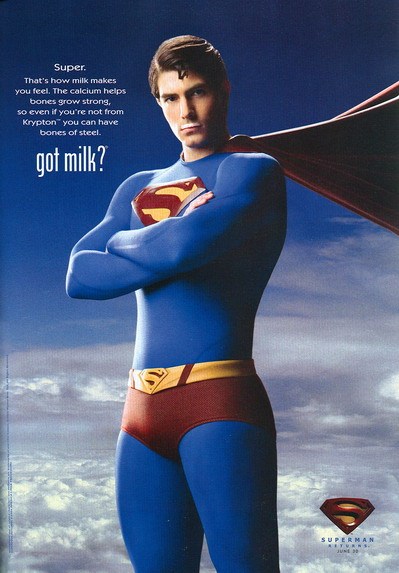Applying the rhetorical situation to images
If you’re in college, chances are you have written a rhetorical analysis of a piece of writing before. Analyzing the tools authors use to influence their audience is a common assignment in most English or literature classes. Recently, applying such analysis to images is becoming a common task as well. Similar to analyzing writing, we can use ethos, pathos and logos to analyze images.
Take this advertisement from 2006:

Ethos (credibility)
Who is publishing this image?
- This is the main point to consider when analyzing credibility. Whether or not information is coming from a trustworthy source is key to making a decision about the effectiveness of an image.
- This image was published by the got milk? advertising campaign to encourage the consumption of milk.
- "got milk?" is a well-known campaign, using a variety of celebrities, characters, and athletes to create effective advertisements.
- Celebrities may not be considered credible advocates for the nutritional benefits of milk.
Who has sponsored this image?
- Besides the actual publisher/creator of an image, who supports the distribution of an image can also affect the credibility.
- This image has been sponsored by the film Superman Returns.
- The Superman franchise has been well loved as a family-friendly producer of films, comics, and merchandise for decades.
- This advertisement has been taken out of context, but you may also consider what types of magazines, newspapers or locations contain the image when completing your analysis
Who is pictured in this image?
- The reputation or physical characteristics of people featured in images affects how they are received.
- Brandon Routh as Clark Kent/Superman
- Because Superman Returns was an early role for Routh, much of the credible draw is from the reputation of the character and not the actor.
- The Superman character is best known for being incredibly strong, relating to the advertisement’s claim that drinking milk will lead to strong bones.
Pathos (emotion)
How does the ad elicit positive emotions in the audience?
- This advertisement relies on positive emotions to sell a product, however other types of images may use characters, colors, and text to inspire a variety of emotions in the audience depending on their purpose.
- Superman is a nostalgic character that appeals to positive feelings for many.
- The ad uses a conventionally attractive man, such as Routh, as a positive visual component.
- Using the character close to the release of the film associates milk with the likely anticipation for the new movie.
- Humor in the text of the advertisement leads to laughter.
- Jokes are often more memorable than information presented in a straight-forward manner.
- The advertisement uses bright, happy, primary colors to draw the eye.
- Second-person perspective in the text makes it feel as though the ad is directly speaking to the audience
Logos (logic)
What claims does this image make? How do they support these claims?
- Logic will often rely on data, statistics, factual claims, and appeals to “common sense” in order to convince an audience their purpose is logical.
- The advertisement claims that the calcium in milk will help make the consumer’s bones strong.
- The conclusion is that drinking milk will make you feel “super”.
- This advertisement does not contain statistics, citations or appeal to logic outside the basic claim, therefore relying more on ethos and pathos.
Contributor: Emily K. Tudorache